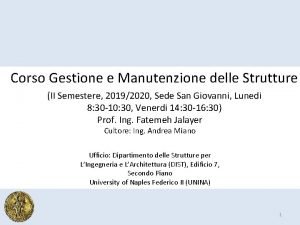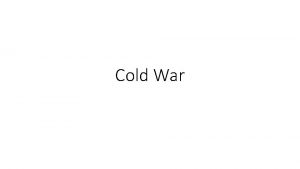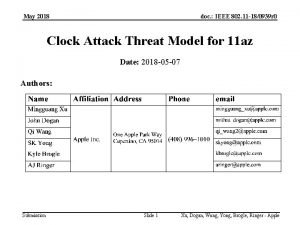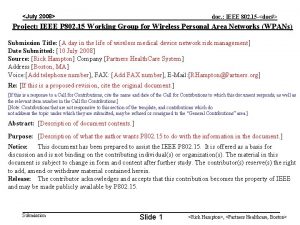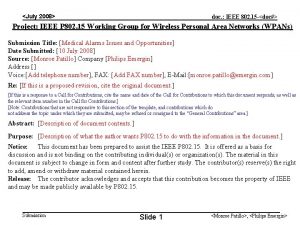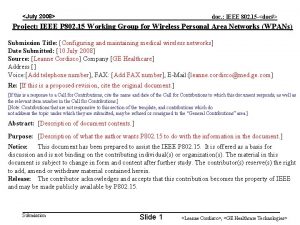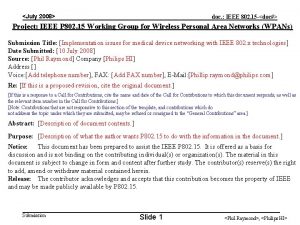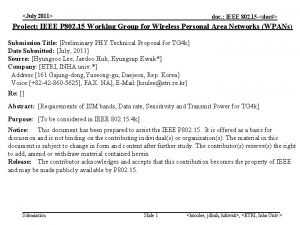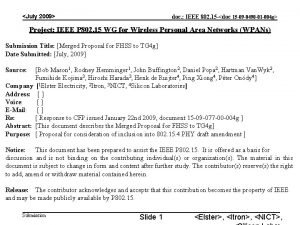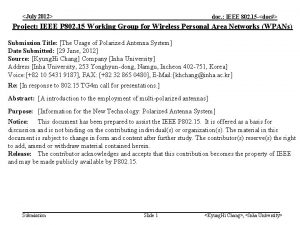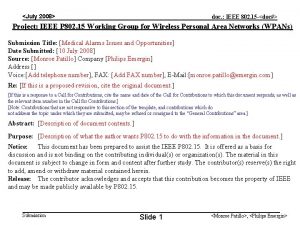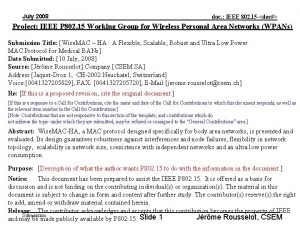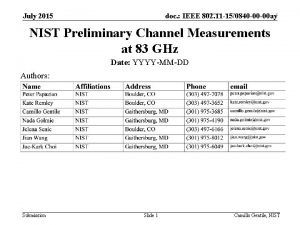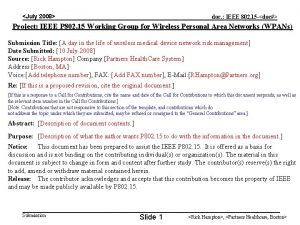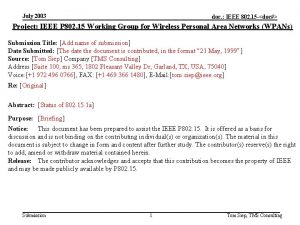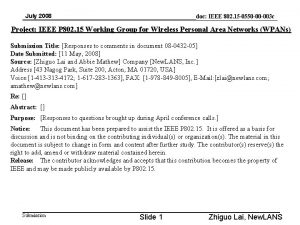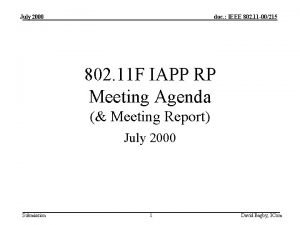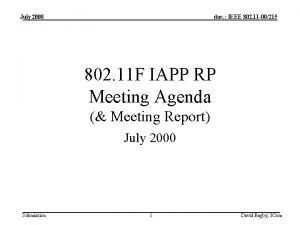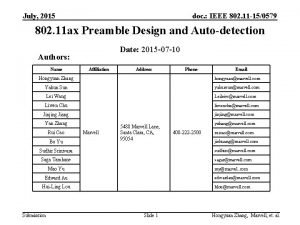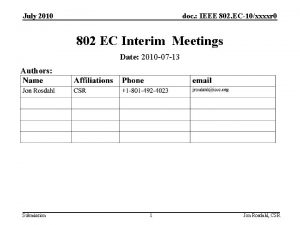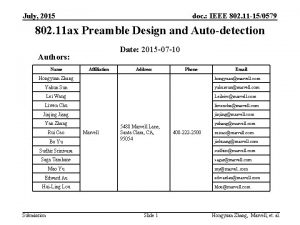July 2018 doc IEEE 802 11 180939 r





















![July 2018 doc: IEEE 802. 11 -18/0939 r 1 References [1] IEEE 802. 11 July 2018 doc: IEEE 802. 11 -18/0939 r 1 References [1] IEEE 802. 11](https://slidetodoc.com/presentation_image_h2/61a8a281aae65a43db8df8fdf453d6fe/image-22.jpg)
- Slides: 22

July 2018 doc: IEEE 802. 11 -18/0939 r 1 Clock Attack Threat Model for 11 az Date: 2018 -07 -02 Authors: Submission Slide 1 Xu, Dogan, Wang, Yong, Brogle, Ringer, Apple Want, Google

July 2018 doc: IEEE 802. 11 -18/0939 r 1 Abstract • 11 az FRD [1] describes Type A and Type B adversaries that are characterized according to attacker’s response time. – – Type A: 1 ms response time. VHT/HE Type B: 1 ms response time. DMG/EDMG Type B: 10 ns response time. A few security threat models are listed in [2][3][4]. • Another threat model, “clock attack” is presented in this submission. – We consider an I-STA which attempts to estimate the frequency offset between its own clock and that of R-STA and uses this estimate to correct timing information reported by R-STA. – Attacker exploits the estimation and correction process performed by the I-STA to decrease the estimated range between I-STA and R-STA. Submission Slide 2 Xu, Dogan, Wang, Yong, Brogle, Ringer, Apple Want, Google

July 2018 doc: IEEE 802. 11 -18/0939 r 1 Round Trip Time (RTT) RTT = (t 4’ - t 1’) - (t 3 - t 2) • t 4’ , t 1’: determined by I-STA from (t 4, t 1) reported by R-STA. – R-STA reports (t 4, t 1) based on its clock and time-of-arrival and departure of packets (see figure). – Transformation of (t 4, t 1) to (t 4’ , t 1’) requires an estimate of clock difference between R -STA and I-STA. – I-STA can reduce the ranging error by utilizing the clock difference in certain cases. Submission Slide 3 Xu, Dogan, Wang, Yong, Brogle, Ringer, Apple Want, Google

July 2018 doc: IEEE 802. 11 -18/0939 r 1 Clock Attack (1) • Method of attack: – I-STA and R-STA involved in FTM are isolated. • Either opportunistically as in figure below. • Or by amplifying the modified signal relative to original transmission. – Attacker relays the signal it receives from R-STA after intentionally mixing it to a slightly different frequency. • Analog mixing can be used, beyond the response time of Type B adversary, but it is easy for an attacker to implement. – Introduced frequency offset may affect estimated range if I-STA tries to correct for the detected frequency offset between center frequencies into ranging calculations. Submission Slide 4 Xu, Dogan, Wang, Yong, Brogle, Ringer, Apple Want, Google

July 2018 doc: IEEE 802. 11 -18/0939 r 1 Clock Attack (2) • Attacker capability: – Signal mixing: • Commercial, off-the-shelf wideband RF mixer (up to multiple-gigahertz bandwidth) and evaluation kits are available, for example: http: //www. analog. com/en/products/rf-microwave/mixers. html • Mixing can be performed by analog components with nanosecond delay. As a result, we ignore the processing delay introduced by the mixer. – Duplex mode: • Attacker does not necessarily have to operate in full-duplex mode. • It can use two co-located hardware equipped with high-directional antennas, e. g. , for Rx and Tx, respectively, for example, horn antennas: https: //en. wikipedia. org/wiki/Horn_antenna Submission Slide 5 Xu, Dogan, Wang, Yong, Brogle, Ringer, Apple Want, Google

July 2018 doc: IEEE 802. 11 -18/0939 r 1 Clock Attack (3) • Definitions – T 1 ->4 = SIFS + Duration. FTM_pkt + 2 x propagation_delay. • True time between FTM is transmitted and ACK is received. – T 2 ->3 = SIFS + Duration. FTM_pkt. • True time between FTM is received and ACK is transmitted. – f. R-STA: Clock at R-STA. – f. I-STA: Clock at I-STA – Δfspoof: Spoofed clock offset, i. e. , the amount of frequency offset introduced by attacker. – Duration. FTM_pkt: Depends on MCS and payload size. T 1 ->4 T 2 ->3 Note: The attack is illustrated using the FTM packet sequence, but it is also applicable to HEz and VHTz. Submission Slide 6 Xu, Dogan, Wang, Yong, Brogle, Ringer, Apple Want, Google

July 2018 doc: IEEE 802. 11 -18/0939 r 1 Clock Attack (4) • Relationship between reported and true elapsed time: – The following expressions represent the relationship between true and reported values (on the left hand side): – When a device’s clock is operating at a lower rate than nominal value, the reported elapsed time is smaller than true elapsed time. • I-STA estimates the frequency offset ( Df ) between the received R-STA waveform and its own clock: – Submission is the amount of frequency offset introduced by attacker. Slide 7 Xu, Dogan, Wang, Yong, Brogle, Ringer, Apple Want, Google

July 2018 doc: IEEE 802. 11 -18/0939 r 1 Clock Attack (5) • I-STA ‘corrects’ the timing reported by R-STA assuming its own clock is perfect (i. e. , equal to fc ): – Since true value of elapsed time is related to reported time as: – And estimated R-STA clock frequency by I-STA is: • By substitution: – Submission is the amount of frequency offset introduced by attacker. Slide 8 Xu, Dogan, Wang, Yong, Brogle, Ringer, Apple Want, Google

July 2018 doc: IEEE 802. 11 -18/0939 r 1 Clock Attack (6) Submission Slide 9 Xu, Dogan, Wang, Yong, Brogle, Ringer, Apple Want, Google

July 2018 doc: IEEE 802. 11 -18/0939 r 1 Clock Attack (7) Submission Slide 10 Xu, Dogan, Wang, Yong, Brogle, Ringer, Apple Want, Google

July 2018 doc: IEEE 802. 11 -18/0939 r 1 Numerical Results (1) • Range error= rangeest-rangetrue – Note: Attacker wants to induce a large negative range error. • HT (11 n), 20 MHz. • Assumption: – Case 1: f. I-STA=fc. – Case 2: f. I-STA – fc = 25 ppm. – Case 3: f. I-STA – fc = -25 ppm. • Packet duration: – – Submission MCS-1: worse-case scenario. Distance=20 m. propagation delay is negligible. Case 1: without option fields, Duration. FTM pkt=64 ms Case 2: with LCI=44 Bytes, Duration. FTM pkt=120 ms Slide 11 Xu, Dogan, Wang, Yong, Brogle, Ringer, Apple Want, Google

July 2018 doc: IEEE 802. 11 -18/0939 r 1 Numerical Results (2) • Submission Slide 12 Xu, Dogan, Wang, Yong, Brogle, Ringer, Apple Want, Google

July 2018 doc: IEEE 802. 11 -18/0939 r 1 Numerical Results (3) • Case 2: 25 ppm for I-STA. • Similar observations as in Case 1: 0 ppm for I-STA. Submission Slide 13 Xu, Dogan, Wang, Yong, Brogle, Ringer, Apple Want, Google

July 2018 doc: IEEE 802. 11 -18/0939 r 1 Numerical Results (4) • Case 3: -25 ppm for I-STA. • Similar observations as in Case 1: 0 ppm for I-STA. Submission Slide 14 Xu, Dogan, Wang, Yong, Brogle, Ringer, Apple Want, Google

July 2018 doc: IEEE 802. 11 -18/0939 r 1 Clock Attack (8) Submission Slide 15 Xu, Dogan, Wang, Yong, Brogle, Ringer, Apple Want, Google

July 2018 doc: IEEE 802. 11 -18/0939 r 1 Clock Attack (9) Submission Slide 16 Xu, Dogan, Wang, Yong, Brogle, Ringer, Apple Want, Google

July 2018 doc: IEEE 802. 11 -18/0939 r 1 Clock Attack (10) Submission Slide 17 Xu, Dogan, Wang, Yong, Brogle, Ringer, Apple Want, Google

July 2018 doc: IEEE 802. 11 -18/0939 r 1 Discussion • Range reduction vs. Clock attack: – Range reduction is <1 m if clock attack is <50 ppm. – Range reduction is ~4 m if clock attack is 200 ppm. • Discussion: – 25 ppm: 802. 11 spec requirement for carrier frequency accuracy (for 2. 4 GHz, 20 ppm for 5 GHz). – If I-STA believes that the clock difference cannot be large than 25 x 2=50 ppm, – Then I-STA can detect the clock attack and range reduction is about 1. 5 meters. • Question: Can I-STA discard measurements if estimated clock difference is beyond a threshold? Submission Slide 18 Xu, Dogan, Wang, Yong, Brogle, Ringer, Apple Want, Google

July 2018 doc: IEEE 802. 11 -18/0939 r 1 Summary • Clock attack is possible if attacker relays received signal with frequency offset intentionally added. • We presented a threat model titled as “Clock Attack” and showed that spoofed range can be large if there is a wide range of valid clock difference. • Clock attack can be detected and avoided if there is stringent requirement on carrier frequency offset. – I-STA can discard measurement if the estimated clock difference is beyond a specified threshold. Submission Slide 19 Xu, Dogan, Wang, Yong, Brogle, Ringer, Apple Want, Google

July 2018 doc: IEEE 802. 11 -18/0939 r 1 Recommendation to 11 az • Add an informative note on receiver behavior in 802. 11 az spec. • To state that an I-STA should discard ranging measurements or terminate a range session when it detects an unacceptable amount of clock error. • Suggested text: – “Note: It is recommended that a device discards ranging measurements when it detects that its ranging peer’s clock drift considering its local clock, exceeds the allowed tolerance from the values specified by the 802. 11 requirements. See section 21. 3. 17. 3 for VHTz, 28. 3. 18. 3 for HEz, and 20. 3. 3. 2. 1 for DMGz/EDMGz. ” Submission Slide 20 Xu, Dogan, Wang, Yong, Brogle, Ringer, Apple Want, Google

July 2018 doc: IEEE 802. 11 -18/0939 r 1 Strawpoll • Do you support to add the following recommended note in the 11 az spec? – “Note: It is recommended that a device discards ranging measurements when it detects that its ranging peer’s clock drift considering its local clock, exceeds the allowed tolerance from the values specified by the 802. 11 requirements. See section 21. 3. 17. 3 for VHTz, 28. 3. 18. 3 for HEz, and 20. 3. 3. 2. 1 for DMGz/EDMGz. ” • Y: N: • Absent: Submission A: Slide 21 Xu, Dogan, Wang, Yong, Brogle, Ringer, Apple Want, Google
![July 2018 doc IEEE 802 11 180939 r 1 References 1 IEEE 802 11 July 2018 doc: IEEE 802. 11 -18/0939 r 1 References [1] IEEE 802. 11](https://slidetodoc.com/presentation_image_h2/61a8a281aae65a43db8df8fdf453d6fe/image-22.jpg)
July 2018 doc: IEEE 802. 11 -18/0939 r 1 References [1] IEEE 802. 11 -16/424 r 11, 11 az FRD. [2] IEEE 802. 11 -17/0120 r 2: “Intel secured location threat model”, B. Abramovsky, O. Bar-Shalom, and C. Ghosh, January 2017. [3] IEEE 802. 11 -17/0612 r 0: “CP-replay attack threat model”, M. Xu, J. Dogan, K. Brogle, AJ Ringer, SK Yong, and Q. Wang, June 2017. [4] “Secure LTF processing”, C. Berger, N. Grandhe, and L. Chu, February 2018. Submission Slide 22 Xu, Dogan, Wang, Yong, Brogle, Ringer, Apple Want, Google
 Bridges from 802.x to 802.y
Bridges from 802.x to 802.y Bridges from 802.x to 802.y
Bridges from 802.x to 802.y Ieee 802
Ieee 802 Ieee 802 family
Ieee 802 family Ieee 802 3 compliance
Ieee 802 3 compliance Ieee802.22
Ieee802.22 Arquitetura ieee 802
Arquitetura ieee 802 Ieee 802 que es
Ieee 802 que es Ieee 802 standard
Ieee 802 standard Bluetooth ieee 802
Bluetooth ieee 802 802 ieee
802 ieee B a f c j e
B a f c j e Ntc 2018 neve
Ntc 2018 neve July 1-4 1863
July 1-4 1863 July 26 1953
July 26 1953 Harris burdick captain tory
Harris burdick captain tory July 12 1776
July 12 1776 July 10 1856
July 10 1856 2003 july 17
2003 july 17 July 14 1789
July 14 1789 June too soon july stand by
June too soon july stand by Poppies in july aoifes notes
Poppies in july aoifes notes Gcc july 2020
Gcc july 2020












